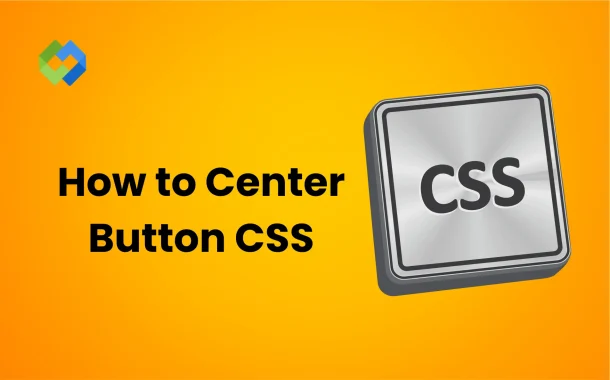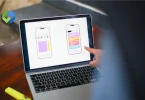Button placement plays a big role in user experience (UX). If a button is not centered or placed properly, it can confuse or frustrate users. A well-placed button improves navigation and makes it easier for users to take action.
Table of Contents
Table of Contents
Methods to Center a Button Horizontally
There are several ways to center a button horizontally in CSS. The method depends on the layout and the type of container you are working with.
1. Using Text-Align
When your button is inside a container (like a div), you can use text-align: center; on the container. This method works for inline or inline-block elements, like buttons. The text-align property aligns all inline-level elements, including buttons, in the center of the container. However, this method won’t work if the button is a block-level element.
2. Using Margin Auto
For buttons set as block elements (display: block; or display: inline-block;), you can use margin: 0 auto; to center the button. This method tells the browser to automatically calculate equal left and right margins, pushing the button to the middle. Make sure the button has a defined width, or it won’t center properly. This method is reliable for block-level buttons in most layouts.
3. Using Flexbox
Flexbox is a powerful layout system in CSS that easily handles centering. To center a button horizontally, set the parent container to display: flex;, and apply justify-content: center;. This will center the button within the container. Flexbox also makes it easy to handle responsive layouts, as the centering adjusts automatically when the container size changes.
4. Using Grid Layout
CSS Grid provides another effective method for centering elements. To center a button inside a grid container, you can apply justify-content: center; to the container, which aligns all grid items, or use justify-self: center; directly on the button. The Grid layout method is ideal for more complex designs where you need precise control over multiple elements in rows and columns.
Methods to Center a Button Vertically
Centering a button vertically in CSS can be a bit more challenging than horizontal centering, but several techniques can help depending on the layout.
1. Using Line-Height
For buttons that are inline or have text content, you can set the line-height equal to the height of the container. This works well when the button is in a single-line text block. It vertically centers the text within the button, but it only works for text elements or inline buttons.
2. Using Padding and Height Adjustments
Another method is using padding to create vertical space. You can set equal padding for the top and bottom of the button or container to visually center it. However, this method depends on knowing the exact height of the button and the container. It is less flexible but can be effective for simple layouts.
3. Using Flexbox
Flexbox makes vertical centering simple. By setting the container to display: flex; and applying align-items: center;, the button will be centered vertically. This is the most efficient method, as it adjusts automatically regardless of the height of the container or button. It works well for responsive designs.
4. Using Grid Layout
CSS Grid also allows for vertical centering. You can use align-items: center; on the grid container to vertically center all items within it. Alternatively, apply align-self: center; to the button itself. This method is useful when working with grid-based layouts that require precise control over both horizontal and vertical alignment.
Centering a Button Both Horizontally and Vertically
Centering a horizontally and vertically button in CSS can be done efficiently using several methods.
Using Flexbox
Flexbox is one of the easiest ways to center a button both horizontally and vertically. First, set the container to display: flex;. Then, use justify-content: center; to align it horizontally and align-items: center; to align it vertically. This method is responsive and works well for different screen sizes, adjusting automatically as the container’s size changes.
Using Grid Layout
CSS Grid is another powerful tool for centering both horizontally and vertically. Set the container to display: grid; and apply justify-content: center; and align-items: center; to center the button in both directions. This is especially useful for more complex layouts with multiple grid items.
Using Positioning and Transform
For more manual control, you can use position: absolute; and CSS transform. First, set the container to position: relative;, then set the button to position: absolute;. Use top: 50%; and left: 50%;, and then apply transform: translate(-50%, -50%); to center the button. This method is flexible but may require fine-tuning for responsive layouts.
Using CSS Variables for Dynamic Centering
For more complex designs that require dynamic centering, you can use CSS variables to adjust the button’s position based on container size. This method is often combined with Flexbox or Grid for better control and adaptability across different screen sizes.
Centering a Button Inside Different Containers
Each method offers different advantages depending on the layout and design requirements of your webpage.
Centering Inside Divs or Sections
For a standard div or section container, you can use Flexbox or Grid to center the button. Set the container’s display property to flex or grid, and apply appropriate centering rules. With Flexbox, use justify-content: center; and align-items: center; to center the button both horizontally and vertically. With Grid, apply justify-content: center; and align-items: center; to achieve the same result.
Centering Inside Forms
When centering a button within a form, Flexbox can be applied to the form container. If the form itself is already set to display: flex;, you can use justify-content: center; to align the button horizontally. If the form container has other elements, make sure the form’s height is enough to ensure vertical centering if needed.
Centering Inside Responsive Layouts
For responsive layouts, Flexbox and Grid are particularly useful. Use media queries to adjust the centering based on screen size. Set the container to display: flex; or display: grid;, and apply centering rules. For smaller screens, ensure the button remains centered by adjusting the container’s height or width using CSS variables or media queries.
Centering Inside a Fixed or Floating Container
For containers with fixed or floating positions, ensure the button is centered relative to the container’s dimensions. Use position: absolute; and transform techniques if the container is positioned. Set the container to position: relative;, then position the button using position: absolute; with top: 50%; and left: 50%;, and apply transform: translate(-50%, -50%); for perfect centering.
Centering Multiple Buttons
When you need to center multiple buttons, the approach can vary depending on whether they are arranged in a row, column, or grid.
Aligning Buttons Horizontally in a Row
To center multiple buttons in a horizontal row, you can use Flexbox. Set the container to display: flex; and apply justify-content: center;. This will align all buttons horizontally in the center of the container. Ensure the buttons have consistent spacing using a margin if needed.
Aligning Buttons Vertically in a Column
For vertical alignment, set the container to display: flex; with flex-direction: column; and align-items: center;. This will center the buttons vertically within the container. Use gap to control the spacing between the buttons.
Spaced and Centered Buttons in Flexbox
If you want multiple buttons to be centered with equal spacing around them, use justify-content: space-between; or space-around; in a Flexbox container. This evenly spaces the buttons while keeping them centered in the container.
Centering Buttons in a Grid Layout
For more complex layouts or when working with a grid, use CSS Grid. Set the container to display: grid; and apply justify-content: center; and align-items: center; to center the buttons horizontally and vertically. Define grid columns if needed to control button placement.
Conclusion
Centering buttons in CSS is crucial for creating a balanced and user-friendly design. By using methods like Flexbox, Grid, and traditional margin techniques, you can easily align buttons both horizontally and vertically within their containers. Flexbox and Grid offer powerful and flexible solutions, making it straightforward to center buttons in responsive and complex layouts.
Choose the centering method based on your specific needs and layout. For simple designs, margin auto or text-align can be effective. For more control, Flexbox and Grid provide robust options. Mastering these techniques will help you create visually appealing and well-aligned buttons that enhance the user experience.














